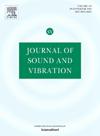Ensuring supercritical Hopf bifurcation in tool chatter using a nonresonant limit cycle absorber
IF 4.3
2区 工程技术
Q1 ACOUSTICS
引用次数: 0
Abstract
Regenerative tool chatter in turning is generally subcritical, resulting in rapid vibration escalation and tool separation upon stability loss. In contrast, a supercritical bifurcation would yield smaller vibrations, enabling a gradual return to stability. This study demonstrates that a light, nonresonant, secondary, limit cycle vibration absorber (LCVA) can alter the subcritical Hopf bifurcation in regenerative machine-tool chatter to supercritical. The absorber, being nonresonant, does not require precise tuning. We first obtain asymptotic approximations for different segments of the linear stability boundary to be used subsequently in the multiple scales analysis. Amplitude evolution equations thus obtained are recast into a canonical form, which reveals that three nondimensional parameters govern the coupled system’s qualitative behaviours. We find a criterion to ensure a supercritical Hopf bifurcation, and demonstrate supercriticality along the complete second stability lobe. We also show that the resulting tool chatter is completely quenched in the initial stages of instability and further incursions into the linearly unstable regime results in conditional appearance of chatter with finite amplitude tool chatter without separation. Tool chatter robustly appears at even larger incursions. Thus, bistability is shifted from the linearly stable regime to the unstable regime, allowing machining close to or beyond the linear stability boundary which results in better productivity. Numerical results from DDE-BIFTOOL substantiate these results.

求助全文
约1分钟内获得全文
求助全文
来源期刊

Journal of Sound and Vibration
工程技术-工程:机械
CiteScore
9.10
自引率
10.60%
发文量
551
审稿时长
69 days
期刊介绍:
The Journal of Sound and Vibration (JSV) is an independent journal devoted to the prompt publication of original papers, both theoretical and experimental, that provide new information on any aspect of sound or vibration. There is an emphasis on fundamental work that has potential for practical application.
JSV was founded and operates on the premise that the subject of sound and vibration requires a journal that publishes papers of a high technical standard across the various subdisciplines, thus facilitating awareness of techniques and discoveries in one area that may be applicable in others.
 求助内容:
求助内容: 应助结果提醒方式:
应助结果提醒方式:


